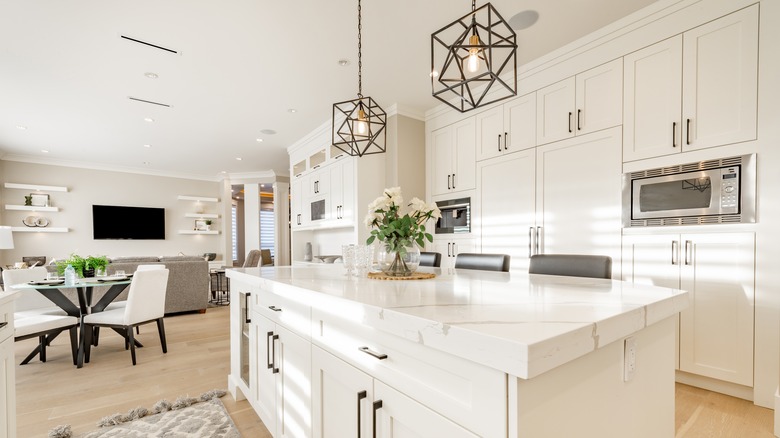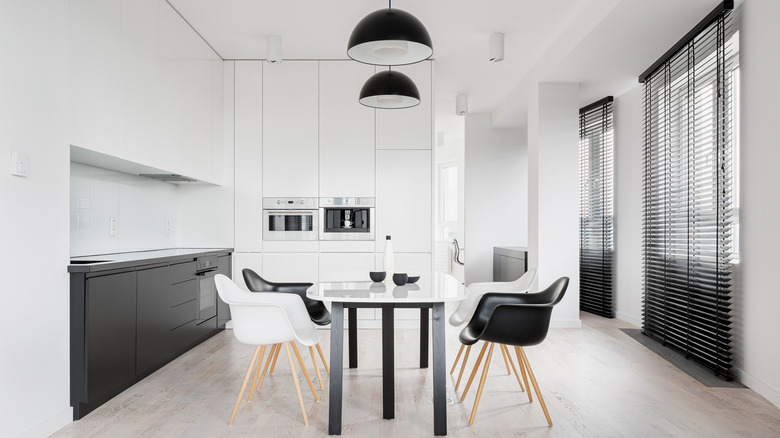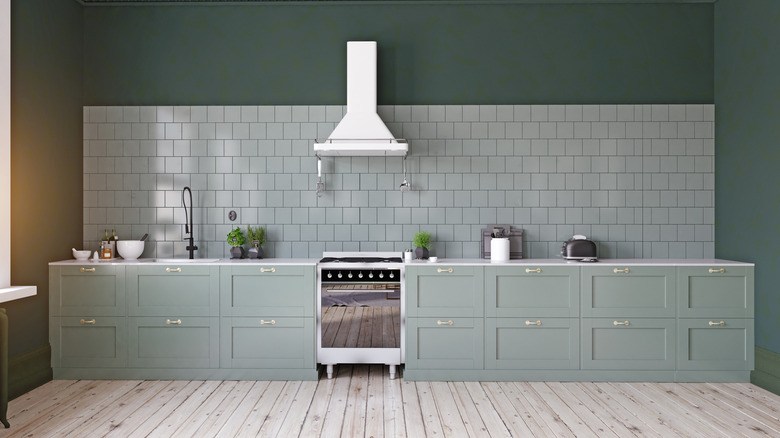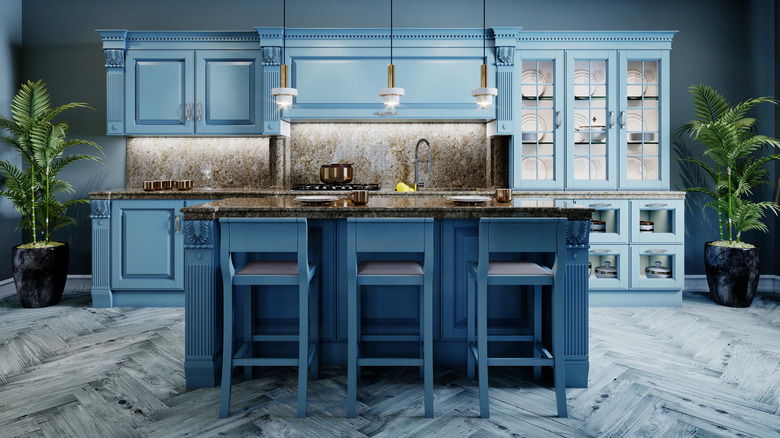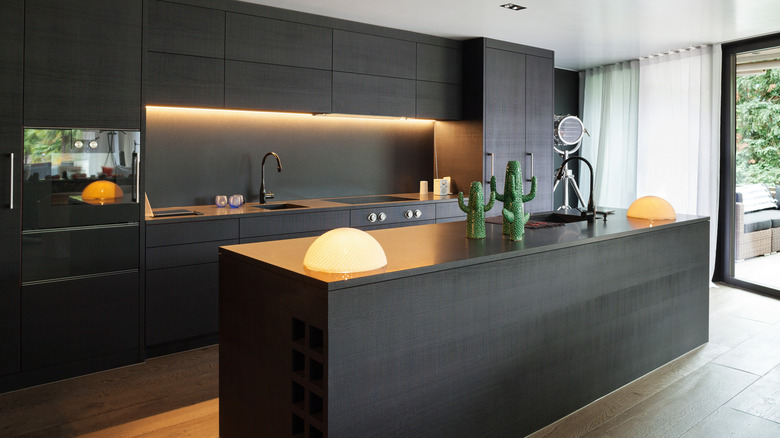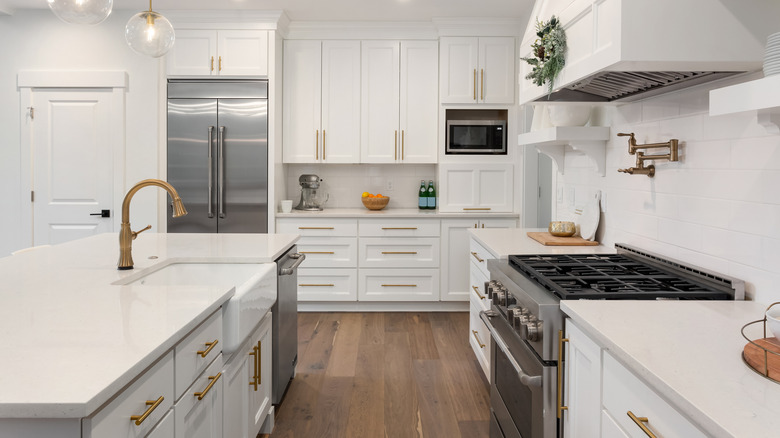How To Design A Beautiful Monochromatic Kitchen
Monochromatic spaces sometimes get a bad reputation — some assume that they're boring or don't have personality. However, this couldn't be further from the truth. While they may lack color, they definitely don't lack interest.
While any room in the home could be monochromatic, perhaps one of the best areas is the kitchen. This is because just using one color in the kitchen can give it an extra clean and elegant appearance. Further, this space utilizes many different materials, from the countertops to the cabinets to the floors, which will allow you to add interest without diverting from one single color. Additionally, a monochromatic design can also make smaller kitchens feel much larger.
Decoraid says that this simplistic design choice is easier to pull off than you might think. However, there are definitely some things you'll need to add to make your room appear dynamic and interesting. If you're thinking about transforming your kitchen into a beautifully monochromatic space, below are five things you'll need to do.
Consider the color
The first thing you'll need to decide on is the color. Of course, this is quite important, since only one color is used in monochromatic spaces. According to Kitchen Magic, most people choose neutral tones because they're timeless and can make selling your home easier. A popular choice is all white, which looks clean and luxurious. Melton Design Build names some other popular color choices. These include gray with steel appliances, which gives an extra modern appearance; beige, which is warm and inviting; and a combination of black and white, which provides an interesting contrast.
If you want to choose a bolder color, perhaps leaning into a theme would make sense, per My Home Products & Decor. For instance, those who love the forest may choose green, while those who love the beach may choose blue. Or, you could focus on the mood you want to create in the space. Maybe you want a more moody atmosphere — if so, you could choose black or dark blue. If you want a brighter and more optimistic feel, yellow or a pastel color could work for you.
Mix lots of shades
Perhaps you've assumed in the past that monochromatic spaces always look boring. However, if they're designed correctly, this isn't the case. This is because, while monochromatic rooms only use one color, they also utilize many different shades. My Home Products & Decor says that, if you choose a bright color like blue or green, while using lots of various shades, you could also add in some black and white pieces to create more interest.
According to Mansion Global, mixing shades while staying in the same general color family is extremely important in monochromatic spaces. Mixing light and dark shades together will create interest and make your room appear more dynamic. However, they also say to avoid creating huge contrasts, as these could feel overwhelming and take away from a relaxing atmosphere. In the kitchen, you could use a different shade for the cabinets, walls, backsplash, flooring, and other furniture pieces.
Decorate with texture and pattern
Texture acts in the same way that different shades do in a monochromatic space — it creates a more dynamic appearance. Kitchen Magic suggests mixing lots of different finishes and materials in your kitchen. For instance, you could use matte cabinet paint, stainless steel appliances, clay vases, leather stools, and glossy backsplash tiles in your design. All these different finishes will stand out in a monochromatic kitchen, as the viewer won't be distracted by any varying colors.
Just like texture, Distinctively U Designs says that patterned elements are also a great way to add visual dimension to a space. They suggest using three different sizes of patterns in large, medium, and small scales. Patterns could be brought into a kitchen through a rug, upholstery, dishes, placemats, or napkins. Additionally, a large-scale patterned piece, like a wallpapered wall, could easily become a focal point in a monochromatic kitchen.
Use lighting to your advantage
While sometimes overlooked, lighting is an important aspect of any space, but it's especially important in monochromatic rooms. This is because lighting can completely change the atmosphere. Sensational Color says that the amount of light you use is important; rooms with dim lighting will look darker, while those with brighter lights will appear lighter in color. Additionally, the color of your light bulbs can also make a massive difference. Choosing a warm bulb will cast a yellow glow over your space, while a cool bulb could make it appear bluer. To make your space feel extra cohesive, try matching the undertone of your main color with your light bulb; for instance, a cool-toned gray would work best with a cool light bulb.
Industville also points out that sconces and chandeliers can add another dynamic look to a room. Light fixtures could easily become the focal point of a monochromatic room and could be used to highlight the subtle shade and texture differences in your kitchen.
Break up the floor and the walls
While mostly everything in your kitchen should be the same color, you don't want everything to look identical. It's important to break up the appearance and color of the floor and the walls so that they don't blend into one another and look boring. Instead, play with shades that complement your main color. For instance, Floor & Decor says that beige floors can look great in a completely white space.
On the other hand, if you want to amp up the appearance of your design, you could always choose to create contrast by mixing light walls with dark floors or vice versa. Similarly, Floors 55 suggests adding a level of interest with a patterned tile floor. Or, you could add a patterned backsplash tile to a kitchen with a wooden floor, which would also break up the design. However, if you choose either of these options and feel like your space doesn't look as monochromatic as you desire, you could add your base color back in with a rug.
